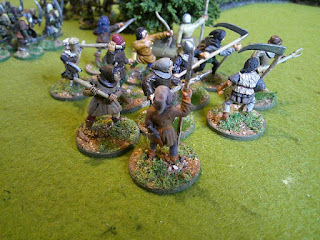Following on from my reflections on my Petaudia medieval.fantasy campaign, I decided to play a Dragon Rampant game, counting it as a "battle" not a "skirmish". To set the context, war has broken out in the Celerian Marches, the central part of the continent. The Baron of the West March has seized control of Castle Doricourt, which is part of the East march. The pretext is that the previous lord of the castle, who died without issue, was his uncle. Anyway, the Baron of the East March was not impressed by this claim andhad already installed his own candidate. So he raised an army and marched to retake the castle. The opposing forces clash nearby.
The two sides had eight or nine units (so bigger than a normal Dragon Rampant game) ; the objective was to beat the other army. I use command bases for leaders, rather than having them incorporated into units as in the rules. They can control "groups" of units. I have brought in the idea of "group" moves - if all the units are within 3" of the command base and the latter passes their Move Activation role, then all units move together. This only applies to normal moves, not charging or shooting - they still have to be individually rolled for per unit.
Since the outcome was not dependent on objectives or Glory points, I experimented as well with an "army morale " idea. Total up the points value of the army. When the value of units destroyed/lost/fled, etc, equals 25% the commander takes a Courage test, subtracting from the two dice the number of actual units lost. If the final number equals or passes his Courage level, the army fights on; if it fails, the army abandons the field and the battle is lost. The next test would be at 33% and then again at 50%.
Anyway, these changes seemed to work okay for this game, but I shall keep experimenting with it. Altering a set of rules does not always work! I played the game solo and the East March won, although at one point I thought the West march was going to do so. The game was much more medieval than fantasy as only two goblin units were involved; the rest of the units were humans. Figures were nearly all Essex25mm metal medieval.
For the terrain, I used a random roll approach:
1d6 is rolled per 1foot square, 4,5 or 6 means a terrain piece is present.
Re-roll 1d6: 1 = Special; 2 = Hill; 3 = Large Wood; 4 = Hedges/fences, etc.; 5 = Small Wood; 6 - Marsh/Reed Beds.
If Special rolled, re-roll 1d6: 1 = Ruin; 2 = Tomb[ 3 = Building; 4 or 5 = Water feature; 6 = Monster's Lair.
To a certain extent, the above options were dictated by the terrain I possess and the quantities thereof. But the results can also be attuned to the scenario, for example a building might be a farmhouse, a watchtower, a mill. The Monster's Lair option is an attempt to get onto the table some of those individual fantasy models I possess but never seem to be used in a game. I also found out recently that perhaps 25% of Britain until well after the end of the Middle Ages used to be covered by marshes and reed beds, so I thought I ought to increase the likelihood of them appearing, given Petaudia is based a bit upon Britain/Western Europe.
A further note of explanation: the Marches used to be one country - Celeria - but split into three. As each country in Petaudia has a colour scheme - Celeria's was yellow and black - the West and East Marches retained those colours. The South March whose intervention in the war is up-coming - is grey and white.
Here are some pictures. I am still experimenting with sub-titles, trying to decide which are best - underneath, alongside, in a corner of the image itself? As always, feedback welcome.




































No comments:
Post a Comment